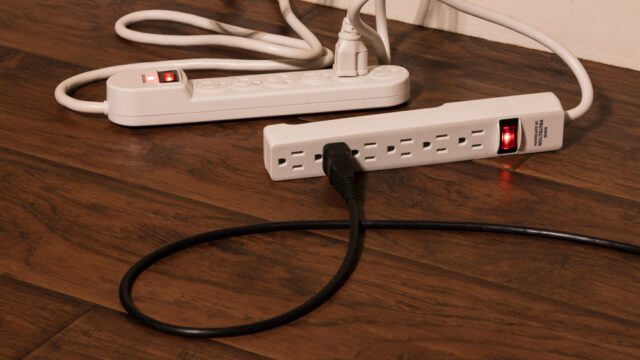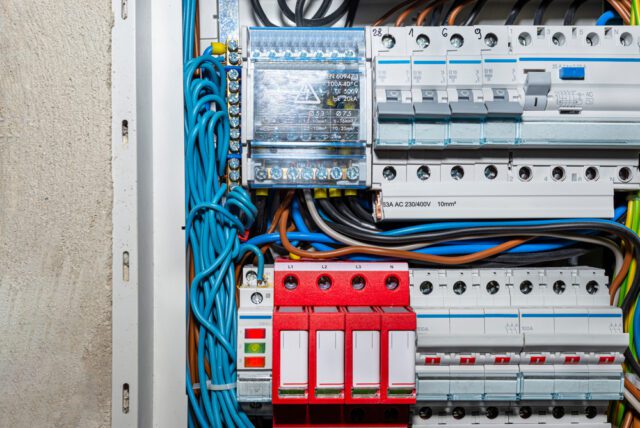We use electricity in our homes pretty much every day—whether we’re cooking food on the stove or powering an iPhone, electricity is fulfilling our daily needs. However, within the intricate networks of circuits and wires lies an electrical problem that many homeowners don’t notice until it’s too late: short circuits. Join us as we dive into the world of short circuits, exploring what causes them, what types there are, and more importantly, how to prevent potential hazards from happening.
Short Circuits Explained
A short circuit is a serious type of electrical accident that damages your electrical system. When you power on your electronics, electricity runs through wires and circuits. Sometimes, the electricity gets blocked, which causes a short circuit. Electricity needs to go somewhere, and if the wires that lead to power on your phone, TV, or lights are blocked or can’t find a pathway, then they take a pathway they’re not supposed to, called a “low resistance pathway.” When electricity travels through a low resistance pathway, that pathway cannot support the amount of electricity, causing a short circuit. Many people disregard short circuits, but it’s important to fully understand how they happen because they can spark and lead to electrical fires.
What Causes Short Circuits?
Unfortunately, there are many reasons why short circuits occur, and they happen to almost everyone. The most common causes of short circuits in residential electrical systems are:
- Old and faulty electrical wiring or connections.
- Loose connections/wiring or overloaded circuits
- Damaged appliances, devices, switches, lights, or other electronics.
- Moisture, pests, or other environmental factors.
- Water or foreign objects like nails or staples coming in contact with electrical wiring.
Keep in mind that there are more reasons why a short circuit happens, and that’s why it’s important to regularly check and inspect your electrical system for the aforementioned causes.
The Types of Short Circuits
- Normal Short Circuit: A normal short circuit is when an electrical wire, or “hot wire” touches a neutral wire. In other words, electricity runs through a low-resistance pathway when it’s not supposed to.
- Ground Fault Short Circuit: A ground fault short circuit is different because the hot wire touches a grounded part of the electrical system instead of a neutral wire. The grounded part could be a metal wall box, bare ground wire, or a grounded portion of an appliance.
Identifying Short Circuits
- Frequent Tripping: If the circuit breakers are tripping frequently, that’s because of short circuits.
- Burnt Smell: If you notice a burning smell or visible scorch marks near outlets or switches, then your electrical system needs to be checked immediately to prevent fire risks.
- Flickering or Dimming Lights: A flickering light could indicate a dying bulb, but it can also indicate short circuits, especially if multiple lights or rooms are flickering.
How to Fix a Short Circuit
To fix a short circuit, make sure that you take all the protective measures to ensure your safety from electrical risks. You can follow these steps:
- Turn off power to the affected circuit.
- Identify and rectify the cause of the short circuit, such as replacing damaged wiring or resetting a tripped breaker.
- Test the circuit to ensure proper functioning before restoring power.
DIY steps for electrical writing are tricky, and sometimes very dangerous. When in doubt, consult a qualified electrician like the ones at T. Webber.
How to Prevent Short Circuits
Every homeowner wants the best protection for their home and family. Follow these tips to minimize the risk of short circuits in your home:
- Avoid overloading circuits by distributing loads evenly.
- Use surge protectors and ground fault circuit interrupters (GFCIs) where necessary.
- Regularly inspect and maintain electrical components, including outlets, switches, and wiring.
Get Help With Short Circuits at T. Webber
At T. Webber, we believe it’s important to understand short circuits, how to identify them, and ways to fix them to ensure the safety of your home. Short circuits can happen for a number of reasons that may be hard to identify at first. But when you notice frequent tripping, a burning smell, or flickering lights in your home, then you are most likely dealing with short circuits that require immediate attention. Call T. Webber to help protect your home from electrical hazards—our team of professional electricians is ready to help!
At T. Webber we’ve come across the same age-old question that many new (and even experienced) homeowners ask: What’s the difference between a power strip and a surge protector? And which one should I be using in my home?
If this is you, you’re not alone. At T. Webber we believe that every resident in the Hudson Valley should know how to better protect their home and what they love inside. Join us as we go through the similarities and differences between surge protectors and power strips so you know which is best for you, and what to look for when making your decision.
What Are Power Strips?
You may already be familiar with power strips or have many in use in your home right now. A power strip has multiple sockets you can plug electrical devices into and receives power from a singular cable designed to be plugged into your wall or electricity source/outlet.

Power strips can be found behind TVs that have many cords or next to other devices that hook up to your TV like DVD players and video game stations that need power. They are also common during the holidays when you’re decorating and need an extension cord to power lights all around your home. There are multiple types of power strips, the most common are plastic coated with an LED switch that turns the strip on and off. Some brands offer better quality than others, and can even make them in fun colors.
Since power strips offer such great convenience, many forget the potential risks that come with them. If you have too much electricity running through the power strip with nowhere to go, it ends up in your electrical devices, causing them to overheat, turn off, or fry.
What Are Surge Protectors?
A surge protector is a type of electrical socket that is also very common in homes. It’s used to protect electrical devices from a power surge with a special circuit inside that allows it to safely redirect a spike in electricity.

There are multiple types of surge protectors, and are differentiated by their “joules,” which is a measurement of energy, similar to watts. It’s important to recognize the joule level in a surge protector so that you get the best one for your needs. When you first buy a surge protector, you’ll notice a label with the level of joules, but this number will deplete over time. A surge protector functions like a reservoir—every time a power surge occurs, the joule level goes down, and the protection it provides decreases. Some types of surge protectors have an indicator on them to let you know when the “reservoir” or joule levels are low, making it easy to remember to replace.
Do I Need a Surge Protector or a Power Strip?
Everybody has different opinions on what they prefer, but there is no denying that surge protectors offer superior protection. The two main differences between a surge protector and a power strip are the level of protection they offer, and how much they cost.
The best rule of thumb to follow if you’re unsure if you need a surge protector or power strip, ask yourself, “Do I want my devices to be protected from a power surge?”
If you answered, “Yes”, then you should go with a surge protector. If you don’t care about protection and want a cheap route to power your electronics, go with a power strip.
The Level of Protection
A power surge offers protection to your electronic devices and a power strip does not. If a surge does occur, your TV, plug-in lights, or anything else connected to a power strip can get fried and destroyed. A surge protector allows you to have peace of mind knowing that you can plug in whatever you want without the worry of them sparking, frying, or never turning on again.
Cost
A power strip is going to cost less than a surge protector since it doesn’t offer protective benefits or special materials. You can find them at almost any store for as low as $5. It’s a cheap upfront cost but can end up costing you more down the road if a power surge happens, and your electronics are damaged and need to be replaced. Making the initial purchase of a surge protector saves you money in the long run and isn’t much more expensive than a power strip anyway, costing only around $30 for a good one.
The Benefits of Surge Protectors
A power strip offers the benefit of allowing multiple devices to be connected to one strip, a surge protector can do that and more. A surge protector offers benefits a power strip couldn’t, such as:
- Protection against power surges and spikes.
- Safeguarding sensitive electronics.
- Long-term cost savings.
- Preventing electrical fires and disasters.
- Peace of mind for homeowners and businesses.
Talk to a T. Webber Electrician About Surge Protectors for Your Home
We hope this blog has now answered the pressing question of whether or not a power strip or surge protector is best for you. A surge protector is the go-to solution for supreme protection against possible voltage spikes that could damage your expensive electronics, appliances, or equipment. A power strip is a quick and easy solution to power multiple devices at once without any protection.
Remember that the professionals at T. Webber are here for you to answer any questions and offer suggestions. If you need help with your surge protectors or have any other electrical concerns, call T. Webber today. Talk to a T. Webber Electrician Today


